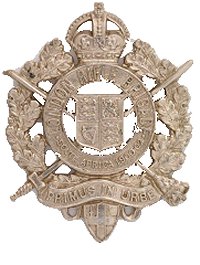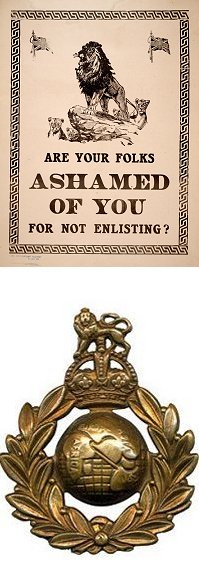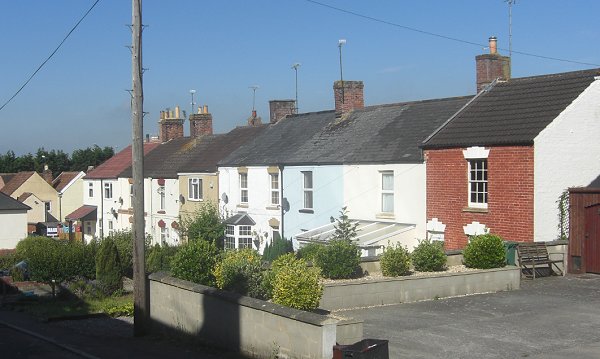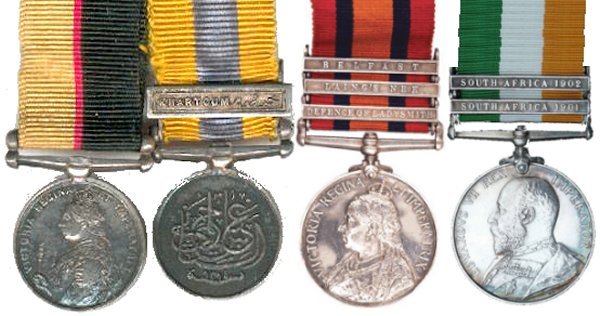yeovil at War
Arthur William Channing
A veteran of the Sudan and Boer Wars
Arthur William Channing was the younger son and fifth of the six children of coal labourer John Channing (b1834), originally from Musbury, Devon, and Mary née Baker (b1835) originally from Edinburgh, Scotland. John and Mary moved around during the early days of their marriage as witnessed by the birthplaces of their children - Thomas (b1867, Quebec, Canada), Susan (b1869, Ottawa, Canada), Rhoda (b1872, Dover, Kent), Louisa (b1875, Winchester, Hants), Arthur William (born 1 April 1876, Yeovil) and Agnes (b1880, Yeovil). The 1881 census listed the family at New Town which, at this time, meant today's Eastland Road and, from later evidence they most likely lived in Wolverton Terrace.
It is known that, before enlisting in the army, Arthur worked as a carriage cleaner for the Great Western Railway.
 Arthur
enlisted in the
Rifle Brigade, serving
for 4½
years as a
member of the
2nd Battalion.
With the
battalion he
served in the
Sudan during the
latter stages of
the Mahdist War.
Arthur
enlisted in the
Rifle Brigade, serving
for 4½
years as a
member of the
2nd Battalion.
With the
battalion he
served in the
Sudan during the
latter stages of
the Mahdist War.
The
Sudan Campain
The Mahdist War
(1881–99) was a
British colonial
war fought
between the
Mahdist Sudanese
of the religious
leader Muhammad
Ahmad bin Abd
Allah, who had
proclaimed
himself the
"Mahdi" of Islam
(the "Guided
One"), and the
forces of the
Khedivate of
Egypt,
initially, and
later the forces
of Britain. The
British
participation in
the war is
called the Sudan
Campaign.
Arthur took part in the Battle of Omdurman on 2 September 1898, when an army commanded by the British General Sir Herbert Kitchener defeated the army of Abdullah al-Taashi, the successor to the self-proclaimed Mahdi, Muhammad Ahmad. Kitchener was seeking revenge for the death of General Gordon in 1884 and the battle was a demonstration of the superiority of a highly disciplined army equipped with modern rifles, machine guns and artillery over a force twice their size armed with older weapons, and marked the success of British efforts to re-conquer the Sudan.
For his service in the Sudan, Arthur was awarded the Queen's Sudan Medal and the Khedive's Sudan Medal with 'Khartoum' clasp (see Gallery).
After the Sudan Campaign, the 2nd Battalion spent several months on Crete.
The
Second Boer War
As war with the
Boer republics
appeared likely
in June 1899,
the War Office
in Britain
dispatched a
total of 15,000
troops to Natal,
expecting that
if war broke out
they would be
capable of
defending the
colony until
reinforcements
could be
mobilized and
sent to South
Africa by
steamship. Some
of these troops
were diverted
while returning
to Britain from
India while
others, such as
the 2nd
Battalion, Rifle
Brigade, were
sent from Sudan
and elsewhere.
Lieutenant
General Sir
George White was
appointed to
command this
enlarged force.
The 2nd Battalion sailed from Crete on the Jelunga on 2 October 1899, and reached Durban on 26 October. At 3am on 30 October the battalion got into Ladysmith by rail.
The Siege of Ladysmith was a protracted engagement in the Second Boer War, taking place between 2 November 1899 and 28 February 1900 at Ladysmith, Natal. A total of 21,000 Boers advanced into Natal from all sides, under the overall command of Louis Botha. White had been advised to deploy his force far back, instead he deployed his forces around the garrison town of Ladysmith. As the Boers surrounded Ladysmith, White ordered a sortie by his entire force to capture the Boer artillery. The result was the disastrous Battle of Ladysmith, in which the British were driven back into the town having lost 1,200 men killed, wounded or captured.
The Boers then proceeded to surround Ladysmith and cut the railway link to Durban. Major General French and his Chief of Staff, Major Douglas Haig escaped on the last train to leave, which was riddled with bullets. Ladysmith was then besieged for 118 days.
From the commencement of the siege the 2nd Battalion, Rifle Brigade, including Arthur held King's Post and Leicester Post on the north of the town, and strained every nerve for weeks to make these posts absolutely unassailable. The rocky nature of the ground, the want of suitable tools, and the fact that many of the diggers had to be on duty in the trenches all night, made the task extremely difficult.
Observation Post, about a mile in advance of King's Post, was until 9 November 1899 held by a weak detachment of the 5th Lancers, who were attacked on that day, and the Rifle Brigade had to reinforce them. The attack was repulsed. The battalion's losses were 1 officer and 1 man mortally wounded and 4 men wounded. They had now to garrison this post and to set about making it impregnable. One very remarkable piece of work done by the battalion was the keeping down of the Boer artillery-fire by the Lee-Metford fire of 'sharpshooters' at ranges between 2000 and 2800 yards.
In December 1899 a sortie was sanctioned to endeavour to destroy the howitzer on Surprise Hill. On the night of 9 December the route was reconnoitered, and on the 10th at 10 pm five companies 2nd Rifle Brigade and a few Engineers reached the hill-top. After some delay the howitzer was found and destroyed. Meanwhile the Boers had gathered in force on the hillside, and 2nd Battalion had to charge with fixed bayonets, never firing a shot. Many Boers were bayoneted. The battalion lost 1 officer and 11 men killed, 36 wounded, and 10 prisoners or missing.
While General Redvers Henry Buller made repeated attempts to fight his way across the Tugela River, the defenders of Ladysmith suffered increasingly from shortage of food and other supplies, and from disease, mainly enteric fever or typhoid. The Boers had long before captured Ladysmith's water supply, and the defenders could use only the muddy Klip River. Towards the end of the siege, the garrison and townsfolk were living largely on their remaining draught oxen and horses (mainly in the form of "chevril", a meat paste named after the commercial beef extract "Bovril").
Eventually, Buller broke through the Boer positions on 27 February 1900. After the protracted struggle, the morale of Botha's men at last broke and they and the besiegers retreated, covered by another huge thunderstorm. Buller did not pursue, and White's men were too weak to do so.
For his part in the action, Arthur received a 'Defence of Ladysmith' clasp to his Queen's South Africa medal (see Gallery) that was awarded only to troops besieged in the town of Ladysmith.
Arthur next took part in the Battle of Laing's Nek between 2 to 9 June 1900. There is, however, very little information available on this battle. Arthur received a 'Laing's Nek' clasp to his Queen's South Africa medal for his part in the action. The clasp was awarded to troops of the Natal Field Force on operations north of an east-west line through Newcastle.
Arthur's final action in the Second Boer War was the Battle of Belfast. Also known as the Battle of Bergendal, this was the last set-piece battle of the Second Boer War. It lasted from 21 to 27 August 1900 and took place on the farm Bergendal (meaning hill and dale) near the town of Belfast. The 5,000 Boers were under the command of General Louis Botha and the 20,000 British Empire forces were led by General Sir Redvers Buller under the overall command of Lord Roberts.
There were several clashes during the battle, but the battle's climax occurred on 27 August, when 74 men of the Johannesburg section of the Zuid Afrikaansche Republiek Politie (ZARP) or South African Republic Police, faced an attack on foot by 1,500 men of the Rifle Brigade including Arthur, accompanied by 2nd Battalion Royal Inniskilling Fusiliers, 1st Battalion Devonshire Regiment and Gordon Highlanders after a heavy artillery bombardment. Despite a tenacious defence by the ZARPs of the kopje (knoll) where they had dug in, they were eventually defeated by the British forces. Twenty of the ZARPs force had been killed and nineteen were taken prisoner. The rest of the ZARPs force escaped and joined the other retreating Boer commandos. British losses were three officers killed and seven wounded, 12 rank and file killed and 100 wounded.
For his part in the action, Arthur received a 'Belfast' clasp to his Queen's South Africa medal. This was awarded to troops east of a north-south line through Wonderfontein (excluding troops garrisoned in Wonderfontein), and west of a north-south line through Dalmanutha Station, and north of an east-west line through Carolina.
Throughout 1901 the battalion was generally in the neighbourhood of the Transvaal - Natal Railway. In January and February a lot of marching was done, sometimes with a column, sometimes taking convoys to Ermelo and other places for other columns. After February they were chiefly engaged in watching the railway, having latterly about forty miles in safe keeping.
Royal
Marine Light
Infantry
Following
his service with
the Rifle
Brigade, Arthur
enlisted in the
Plymouth
Division of the
Royal Marine
Light Infantry
(RMLI) on 15
September 1904
at Exeter. His Register Number
was 14646.
 Arthur's
service record
indicates that
he was 5' 6¾"
(170cm) tall
with a fresh
complexion, dark
brown hair and
grey eyes. He
had a rose
tattoo on his
left forearm and
a cross and
anchor tattoo on
his right
forearm.
Throughout his
military career
both his
character and
ability were
consistently
recorded as
'very good'.
Arthur's
service record
indicates that
he was 5' 6¾"
(170cm) tall
with a fresh
complexion, dark
brown hair and
grey eyes. He
had a rose
tattoo on his
left forearm and
a cross and
anchor tattoo on
his right
forearm.
Throughout his
military career
both his
character and
ability were
consistently
recorded as
'very good'.
The Royal Marines are not part of the British Army but an integral part of the Royal Navy. Up to and during the Great War there were the Royal Marine Light Infantry and the Royal Marine Artillery (RMA). Each was formed as an establishment within the British Royal Marines during the early nineteenth century. As the coats of the RMA were the blue of the Royal Regiment of Artillery, this group was nicknamed the "Blue Marines" and the Infantry element, who wore the scarlet coats of the British infantry, became known as the "Red Marines".
They were organised into three Grand Divisions Based at Chatham, Portsmouth and Plymouth. these divisions did not have an operational role as such but acted in the same way as an Army Regiments depot, they supplied drafts and reinforcements to man the RN ships and the RM Battalions in the 63rd (Royal Naval) Division. Arthur's Port Division was Plymouth, as indicated by his Service Number Ply/14646.
Initially posted to the regimental depot at Deal, he was transferred to become a musician in the band of the Depot Establishment at Plymouth. Between November 1904 and August 1909 Arthur was a musician in the regimental band stationed at Plymouth.
Arthur was recorded in the 1911 census as an unmarried private in the RMLI, stationed at HMS Tamar. HMS Tamar was the name for the British Royal Navy's base in Hong Kong from 1897 to 1997. It took its name from HMS Tamar, , a ship that was used as the base until replaced by buildings ashore (see Gallery). At the turn of the 20th century, during Arthur's period at the base, land adjacent to the site was needed for expansion. Unable to obtain it, as the site was surrounded by army barracks, the Navy began work on the construction of a floating basin (sheltered bay) and the reclamation of the east arm of the dockyard, in 1902. This project, involving 160,000 square metres of land reclamation, a 36,000 square metre floating basin to repair and refit vessels afloat, and also a 183-metre graving dock, was completed by 1908.
At the outbreak of the Great War, in addition to their usual stations aboard ship, Royal Marines were part of the Royal Naval Division. This was an infantry division, formed from Royal Navy and Royal Marine reservists and volunteers, who were not needed for service at sea. It later transferred to the British Army as the 63rd (Royal Naval) Division.
The Deal Battalion was still forming, so only the Chatham, Portsmouth and Plymouth battalions were sent to Flanders; two landing at Ostend on the early morning of 27 August 1914 and the other the next day. They were ordered to hold the town until Belgian troops, who had retreated into France, could be transferred and 4,000 Belgian troops arrived on 30 August. The Marines were re-embarked on 31 September and returned to their ports.
As an Army formation, the Plymouth battalion fought on the Western Front for the remainder of the war. It is not known for certain which actions Arthur took part in during the next couple of years, however he did take part in the Operations on the Ancre, from January to March 1917.
On the north bank of the Ancre, the 63rd Division attacked on 17 February, with the 188th Brigade and two battalions of the 189th Brigade, to capture 700 yards (640 m) of the road north from Baillescourt Farm towards Puisieux, to gain observation over Miraumont and form a defensive flank on the left, back to the existing front line. Two battalions attacked with a third battalion ready on the right flank, to reinforce them or to co-operate with the 18th Division between the Ancre and the Miraumont road. On the northern flank two infantry companies, Engineers and pionéers were placed to establish the defensive flank on the left. The divisional artillery and an army field brigade with 54 × 18-pounder field guns and 18 × 4.5-inch howitzers provided covering fire, with three field batteries from the 62nd Division further north, to place a protective barrage along the northern flank. The darkness, fog and mud were as bad as on the south bank but the German defence was far less effective. The creeping barrage moved at 100 yards (91 m) in four minutes, slower than the rate on the south bank and the Germans in a small number of strong-points were quickly overcome. The objective was reached by 6:40 a.m. and the defensive flank established, a final German strong-point being captured at 10:50 a.m. No German counter-attack was made until the next day, which was stopped by artillery-fire.
The 63rd Division lost 549 casualties, including Arthur Channing who was killed on 23 February 1917. He was aged 40. Arthur was buried at Dernancourt Communal Cemetery Extension, Somme, France, Grave 6/A/32.
Arthur's name is inscribed in the County of Somerset Book of Remembrance in St Martin's Chapel, Wells Cathedral and also on the Yeovil War Memorial in the Borough - albeit written as Channing, A rather than the correct Channing, AW.
gallery

Arthur grew up in Wolverton Terrace, Eastland Road, seen from the north. None of the houses now appear as originally built - red brick with Ham stone heads to windows and doors under a Welsh slate roof. Photographed in 2014.

From his Service Record it is known that, for his service in the Rifle Brigade during the African campaigns, Arthur was awarded the above medals. From left to right these are the Queen's Sudan Medal, the Khedive's Sudan Medal with 'Khartoum' clasp, the Queen's South Africa medal with clasps 'Belfast', 'Laing's Nek' and the 'Defence of Ladysmith' and finally the King's South Africa Medal with clasps '1901' and '1902'.
Following the death of Queen Victoria on 22 January 1901, her eldest son became her successor: King Edward VII. Meanwhile, the Boer War had continued its shift from a conflict involving major battles into one of numerous guerrilla actions. It also introduced the term "commando" to military language. This shift in the type of warfare was reflected in the KSA only having two clasps, compared to the Queen's South Africa Medal which had 26.
The King's South Africa silver medal was issued to personnel who were serving in South Africa on or after 1 January 1901 and who would have completed at least 18 months' service prior to 1 June 1902. Any service in South Africa during 1901 or 1902 that did not meet this criteria was recognised by the award of the appropriate date clasp to the Queen's South Africa Medal. The two clasps (both awarded to Arthur) available with the King's South Africa medal are South Africa 1901 and South Africa 1902. The King's South Africa medal was always issued together with the Queen's South Africa medal, and was always issued with either one or both clasps.

The Commonwealth War Graves Commission certificate in memory of Arthur Channing.